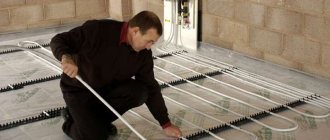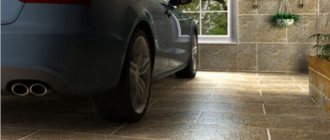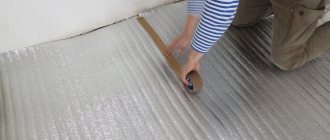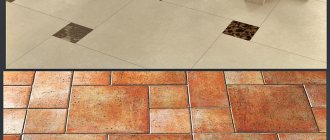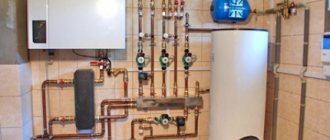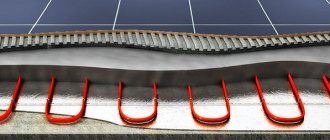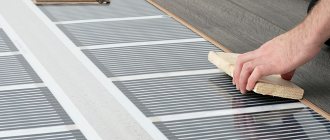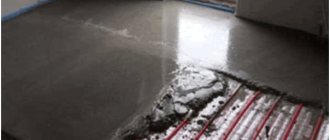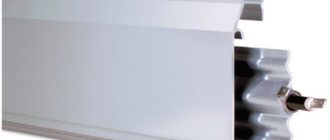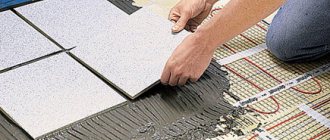A new infrared system has appeared in the family of underfloor heating that generates thermal energy using electricity. If the operating principle of cable underfloor heating and heating mats is clear to the consumer and all their advantages and disadvantages have been studied and tested, then the infrared floor remains a dark horse. Manufacturers of IR films deliberately advertise their products only on the positive side, and sellers will not be able to obtain objective comparative information about cable and infrared floors.
Electric floor heating systems
To get the real picture, it is necessary to compare cable and IR floors in terms of energy savings, safety, ease of installation and reliability, repairability, and room heating efficiency. By comparing these characteristics, you can confidently decide which floor is better suited in a particular situation.
Operating principles of IF and cable heated floors
All features of IR and cable floors, their advantages and disadvantages are due to different methods of generating heat. Cable systems heat up themselves and transfer heat to the environment by contact. The air receives heat from the floor surface and then transfers it to objects in the room. In IR floors, heating of the air in the room occurs according to a different scheme: first, the carbon elements of the film, when electricity passes through them, emit infrared light, which heats the surface of nearby objects. They in turn heat the air. Thus, IR floors heat the room according to the principle that the Earth receives energy from the Sun. A feature of such “dry” heat is the subjective feeling of a higher temperature than it actually is.
In IR systems, an ultra-thin film with soldered carbon elements is used as a radiating conductor. Cable flooring uses a high-resistance wire as a heating element, which heats up when current passes.
Scheme for heating a room using IR film
Manufacturers of IR flooring focus on the beneficial properties of IR radiation. But this is what distinguishes open IR heaters. In this case, infrared radiation hits surrounding objects and people. But in the case of a floor, IR radiation does not extend beyond the floor covering (laminate or linoleum). In fact, it is no different from other systems that use floor heating.
Important! More significant is the level of electromagnetic radiation, which is present in all electrical systems. Its norms still do not have clear scientific justifications, but the fact that it affects biological processes in living organisms has been established.
Therefore, when deciding which underfloor heating is better to choose, film or cable, you need to skip the consultant’s story about the benefits of infrared radiation, which has no practical significance, and focus on more important nuances.
Cable
The operating principle of such devices is simple. The heating wire consists of one or two conductive wires with a very high resistivity coefficient. When an electric current is connected to it, it begins to heat up and transfers heat to all materials with which it comes into contact. The screed inside which the wire passes heats up or the floor covering laid on top of the cable in those structures where the screed is not used becomes warm. The advantages of the solution will be:
- Possibility of installation directly into a layer of tile adhesive when laying under tiles or in a poured mortar.
- The ease of installation of such elements - all work can be carried out even by a person who does not have such experience.
- Lower price compared to film devices.
- Uniform heating of the entire plane.
- Higher power of the entire system.
- Not the highest electricity consumption.
- Heating speed - the time the device reaches the specified mode can be measured in several minutes.
The disadvantages of the solution include lower reliability than film systems. If the cable is damaged, it fails completely, while the film structures are disconnected in sections.
Energy Saving
The next argument, which, in theory, should rid the buyer of any doubts in favor of infrared flooring, is energy savings. In fact, the trick lies deeper than ordinary measurements of the amount of current consumed. In such tests, an electric infrared floor will be 20% more effective than a cable floor. In IR structures, heat is more completely transferred to surrounding objects, without the cost of heating intermediate conductor materials. But the trick is that in such a “pure” measurement the energy intensity of the entire underfloor heating system is not taken into account. Although IR film heats up the floor quickly, it cools down just as quickly when the power is turned off. Thus, in order to maintain a constantly comfortable temperature in the room, the infrared floor must function continuously.
Cable heated floor
In a cable system that is laid in a screed layer, concrete acts as a heat accumulator, and to maintain a constant temperature there is no need for continuous operation of heating elements. Electric thermostat with temperature sensors in cable systems makes them less expensive for constant heating of rooms, despite the higher rated power.
Important! Cable underfloor heating is more efficient if you need to heat a large room.
Today, unbiased experts recommend a reasonable combination of cable and infrared floors in a room. The film floor provides rapid heating to a comfortable temperature, and the cable floor provides subsequent constant heating and maintains the set temperature.
Which underfloor heating is better, electric or water?
Water system
+ Plus:
- If the area of the house is large (more than 60 square meters), then using a water-type floor is economically beneficial.
— Minuses:
- Such a system (like any heating system) needs regular inspection and prevention.
- Installation of water pipes will cost more, and the pipes, filters and pumps themselves will greatly empty your pocket.
- These floors only heat when the heating boiler is on.
Electric floors
+ Pros:
- Possibility of use in any conditions (even in a sauna, swimming pool or on the balcony);
- You can turn on such a floor even in summer, if necessary;
- Quick and easy installation, which can be done not only by builders, but also by non-professionals;
- Managing this floor is extremely easy;
- Temperature adjustment allows you to set the optimum in each room;
- Like ordinary wiring, an electric floor will last at least 50 years without requiring maintenance.
— Minuses:
- If there is no temperature regulator, then it is unprofitable to heat large surfaces of the floor with electricity.
- Electromagnetic radiation, although small, is present. However, the use of a good shielding braid can reduce it to a minimum (300 times less than the norm).
Installation features
The electrical cable circuit is mounted in a layer of screed, which protects it from damage and acts as a radiator. The installation technology is labor-intensive and costly.
Cable heated floor installation diagram
The IR film is spread before laying the finishing coating. This process is not technically complex. In this case, the total cost of installing a heated floor is lower than when installing a heating cable. Although in its pure form, IR film is more expensive than cable for the same room.
Infrared film provides local heating of the floor to a greater extent, while the cable heats the entire screed. Therefore, IR elements are not placed in places where furniture is permanently located.
They prefer to install the film in city apartments, where the floor area is small and low ceilings do not make it possible to raise its surface with an additional cable tie.
IR film is a fast and mobile technology. Without undertaking large-scale renovations, in the process of replacing the old coating, you can install an additional option in the form of an infrared floor and improve home comfort.
Installation diagram of IR film under laminate
This also determines the type of coatings that are used for cable and infrared floors. Any material can be laid on the screed, including tiles, but tiles cannot be placed on IR mats. For infrared film, it is necessary to choose a thin and durable topcoat. The best option is laminate.
Important! When using IR film, great importance is attached to preventing radiation scattering and energy loss. To do this, a foil material with a reflective surface is used as a substrate.
If you plan to lay a soft carpet on top of the IR film, then first you need to make a rigid base in the form of a subfloor made of plywood or OSB. IR heating elements should not be subjected to point mechanical loads.
Installation and connection of electric heated floors.
Important! Before pouring, gluing tiles, or installing laminate, be sure to check the functionality of the assembled heated floor circuit. Remember! There are no miracles, there are bad contacts. Don’t forget to draw a diagram of the heating cable laying to scale, for which it is convenient to use a checkered sheet of paper (as a last resort, take a photo of the mounted diagram). Take my word for it - it might come in handy.
Usually, each ready-made heated floor kit contains instructions for installing and connecting the product. I recommend checking it out. Below are a few nuances and diagrams.
It is best to first prepare the electrical wiring according to the selected diagram. The connection diagram depends on the total power of the floor in a separate room relative to the maximum power of the thermostat.
direct scheme
If you purchased one factory kit, then the load is connected directly to the thermostat terminals.
Important! It is necessary to know exactly the maximum power of the thermostat. Typically this value is 16 A, i.e. 3500 W.
via contactor
contactors
If the kit exceeds 3500 W, then you will exceed the maximum power of the thermostat. In this case, you need to connect your heated floor via a modular contactor. The rated current of the contactor should be selected according to the total load of the heated floor.
The cross-section of power wires for connecting the floors themselves is selected according to this
, and to power the thermostat and connect its output contacts to the contacts (A1 and A2) of the contactor coil, you can use a four-core cable with a cross-section of 1.5 mm² or even smaller. The cores of flexible, stranded wires should first be terminated with lugs or tinned.
Don't do that!
It is best to install the contactor in the panel and run the wires from the floors and the thermostat there. A hole is drilled for mounting the installation box under the thermostat. If the wall is brick or concrete, then you will have to make a groove from the installation box to the groove in the floor. Prepare a groove in the floor for installing the temperature sensor, according to the instructions for the thermostat. A corrugated pipe with a plug is placed in the groove, and a temperature sensor is already placed in the corrugated pipe, the wire of which is connected to the thermostat according to the diagram.
Safety, reliability and service
The difference between cable and infrared floor heating systems in these indicators is also significant.
In terms of reliability and risk of failure of the entire structure, the IR system is superior to cable. The film itself with soldered elements is highly durable. The parallel connection circuit prevents failure of the entire system if a single element breaks down. In a cable floor, if a wire is damaged, the entire system stops working.
IR films are installed without screed, the finishing coating (laminate, linoleum) is laid directly on top of the heating mats. This determines such features of IR systems as:
- ease of installation;
- quickly heat the floor surface to the desired temperature;
- If a separate heating module fails, the system continues to operate, and replacing the damaged element will not be a big problem. Locally dismantling the finishing coating is easier than removing the cable from the screed.
But the modular parallel connection system leads to complication of the electrical part of the design. The use of additional power supplies makes the system vulnerable to power surges.
In terms of safety, some cable floors are preferable to infrared floors. The electrical two-core shielded cable for underfloor heating, located in the thickness of the screed, is practically invulnerable and eliminates electric shock.
Twin-core shielded wire
Film floors are laid directly under the finishing coating, so they are demanding both in terms of the strength of the base and in limiting mechanical loads from above.
But the cable floor also has a weak point: despite the fact that it does not have many connection points for individual modules, the only coupling hidden under the floor surface often fails. Therefore, its location is always marked on the room plan for quick search and replacement.
Electricity consumption issue
When deciding which floor heating would be better - infrared or cable, or its other varieties, one cannot help but discuss such an important issue as the electricity consumption of such heating systems.
Based on the claims of many manufacturers, their products are very efficient in terms of electricity consumption, but it is worth finding out whether this is actually the case. In fact, heating elements are capable of converting generated electrical energy into thermal energy, and the efficiency can reach 99%.
Two types of heated floors: how they work, what are their characteristics
What both systems have in common is that they are hidden under the floor covering, without direct contact with the air in the room. So no convection accompanied by raising dust can occur. Thanks to this, the air does not dry out, as happens when using floor heaters.
We advise you to study - Interior design of an apartment in country style
Water heated floor - convenient, not allowed everywhere
Many people choose water-type heated floors because of their low operating costs. After all, they do not consume electricity, but are connected to the general heating system of the house. This is true, but when they operate, energy consumption increases (usually gas), and a low-power boiler may not be able to cope with the load; moreover, the boiler must be automatic. We have to change this boiler by buying a more powerful current model. Let's also take into account gas costs, so savings (compared to an electric type floor) are achieved only when heating large rooms.
Naturally, it occurred to many that it would be easier and more profitable to connect a water-heated floor in a city apartment that has central heating. As a result, there won’t be any extra expenses – beautiful! This was not the case - such naive people who installed such systems were very mistaken. It turned out that money was thrown away. And all because it is strictly forbidden to connect warm floors to them in houses with central heating. There is also a considerable fine for this.
Water heated floor made of metal plastic.
Heated floors powered by electricity
To make a final decision about which underfloor heating is better - electric or water, you need to take a closer look at designs that run on electricity. There are several varieties: cable system, infrared floor and mini mat system.
#1. Cable heated floor.
This type of “underfloor” heating is a cable system. They consist of separate sections, each of which, in turn, is represented by a shielded cable (with one or two cores) in two-layer insulation. The cables are connected to each other with reliable sealed couplings
All these precautions make the heating system absolutely safe even in rooms where it is very damp
This system is economical - for different rooms you can choose different power of the cable used. After all, in the kitchen or in the hallway there is no need for a floor with a power of 150 to 180 watts per square meter, as for rooms that are not heated (for example, loggias, balconies). A kitchen floor will have enough power of 120 watts per square meter, and for a bathroom – 140 watts per square meter. “Cable” floors are the cheapest of all those that run on electricity. But they need a screed - this is a prerequisite. Because of it, the height of the floor increases.
#2. What are heating mats?
This is also the name for a system of cables, only very thin ones (3 millimeters or less). They are attached to a fiberglass mesh and sold in rolls that look very similar to mats or rugs. That's why they came to be called minimats. They are extremely quickly installed - you just need to roll out such a roll on the base, and then connect the cable to a socket equipped with a temperature regulator. This type is considered the best heated floor for tiles. After all, the tile covering can be glued directly onto the minimats.
#3. Infrared heated floor.
If you use a special infrared film instead of cables, you will get an infrared floor. It also runs on electric current and can even be installed under carpet or laminate flooring and does not require a concrete screed. Moreover, it is quite possible to install it almost instantly - in just a couple of hours. And then you can immediately turn it on and use it, since there is no need to wait for the glue to harden or the cement to set.
This type of “heating” floors is good in the sense that there is absolutely no dirt or dust during installation. Therefore, it can be installed when the apartment is sparkling with a brand new renovation - nothing will get damaged or dirty. Moreover, infrared film can be laid not only on the floor, but also on the walls. If you want, you can even heat the ceiling in your dacha with it. Unless, of course, the price scares you away - carbon film is not cheap.
Film infrared heated floor.
To further understand the features of each type of electric heated floor, we suggest watching the following video.
Advantages of film infrared heated floors
Infrared heated floors have the following advantages:
- The floor warms up quickly. It is comfortable to walk on it;
- The heating film can be laid under laminate or linoleum; there is no need to pour concrete on top. Thus, materials are saved and the height of the room is not reduced. You can also reduce the time it takes to lay the floor. The infrared floor can also be installed under parquet or carpet;
- When exposed to infrared rays, a favorable atmosphere is created in the room, and the air does not become dry.
Types of systems
It will be difficult for a person unfamiliar with the heating system to understand and decide which electric floor is best to choose, so it is worth obtaining information on each type of heating technology in more detail before making your choice.
Electric heated floors are divided into 2 subtypes:
- Infrared floors, which are a system that radiates heat. Heating is carried out on the principle of illuminating the room with warm rays.
- Convection devices are floors where heating occurs directly on the heating element, and from it the heat goes to the screed and finishing coating.
Nowadays, the buyer has a large number of options for heated floors to choose from; depending on the type chosen, the method of installing it also changes.
We advise you to study - How to glue wallpaper on drywall
Heating cable
The principle of operation is the conversion of electricity into heat. If the home owner is puzzled about which warm electric floor to choose under the tiles, it is worth considering first of all the heating cable, which is extremely easy to install. In terms of design features, it is not much different from a regular cable.
Mounted in a screed no less than 2 centimeters thick.
Considering that this is a convection heating system, it is strictly prohibited to use it with laminate flooring.
This device will be the best option for combining it with tiles. As a result of the use of screed and tiles, heat accumulates, maintaining the temperature in the room for a long time, so after heating the device can be turned off for a while. Therefore, when deciding which electric heated floor to choose for tiles, you can leave your choice on the heating cable. And in the photo you can see the styling options.
Heating sections
Electric mats can be convection or infrared, they are produced in rolls, and do not require a thick screed during the process, which is very convenient for the installation process. Convection mats work on the same principle as a heating cable; therefore, they cannot be used under laminate.
If you intend to choose electric heated floors for laminate, then it is better to give preference to infrared heating systems. The heating elements in them are special rods, the ends of which are connected to wires on both sides and placed parallel to each other.
Heating sections have become popular in the market due to the special qualities of the rods, which provide the desired air temperature where it is required. This type of floor is installed without taking into account the placement of furniture, which distinguishes it from previous designs.
Film floor
In fact, a heated floor is an infrared device, the main advantage of which is its thickness of only 0.5 mm. Disadvantage: the structure must be insulated from moisture, so wet laying of the floor is excluded. Such electric heated floors are chosen under laminate or parquet. The film product is an economical option; it only heats when it is plugged in.
Advantages of heated floors
Which heated floor to choose, water or electric, is a question that worries those who have decided to increase the comfort in their home. If we talk about the advantages, then for electrical structures they are undeniable:
- Easy to install - although installation will require a screed, it will be easy to do. IR heated floors and thermomats do not require screed at all; it will be enough to simply lay the heating elements directly under the covering.
- Electric systems guarantee high-quality heating, while with water floors, as the water moves and transfers heat, it cools down. The amount of heat has its own standards, this makes it possible to calculate the power of the cables used as accurately as possible.
- If unprofessional connections are made, water floors run the risk of leaking and flooding neighbors; owners of electrical structures are spared this trouble. If there is a problem with the electrical system, it will be easier to fix it, since getting to the cable will be much easier than getting to the pipeline.
Which heated floors to choose - electric or infrared - each owner must decide independently, based on his financial capabilities, the design features of the floor and the finishing floor covering used.
Installation of a warm water floor
The key to proper installation is a level base of the subfloor. The easiest option to achieve excellent results is to use a quick-drying self-leveling screed. The average consumption per square meter is 15 kg of dry mixture with a layer thickness of 1 cm. Buy it with a 10% reserve. The work is simple:
- Sweep the floor;
- Dilute the dry mixture according to the instructions;
- Fill the floors in the room;
- Wait a day to gain strength.
The next stage is installing thermal insulation. For this purpose, use high-density extruded polystyrene foam sheets. Try to find special mats for heated floors
, from the material described above. This will reduce the labor intensity of all work by 15-17%. Such mats are sheets of expanded polystyrene, which already have special grooves and/or bosses for attaching pipes.
The mats are laid end to end. Gaps between them are not allowed. Because in such places cold bridges appear. Covering mats with foil polyethylene foam is a waste of money. The fact is that a screed will be poured on top of the structure. And under its influence, this metallized layer will collapse within 2-4 weeks. The pipe is laid in the mats according to the prepared diagram.
Please note that when using special mats, you do not need to worry about additional fixation of the pipe using clamps or mounting tape. And securing the pipe is a very painstaking and time-consuming job.
After laying the pipe in the apartment according to the installation diagram, it must be pressure tested. The pressure testing process takes place in several stages:
- Filling the system with coolant;
- Temperature rises 30-50% above normal ( up to 45-50°C
); - Increasing the pressure in the system by 0.2-0.5 Atm;
- Exposure for 24 hours.
During each stage, the condition of the laid pipes and threaded connections should be carefully monitored. If a defect is detected, it is necessary to drain the water and correct the defect. Then the entire check is repeated.
If after 24 hours no leaks are found in the system, then we proceed to the next stage - pouring the screed.
If you used copper or corrugated stainless steel pipes to organize a system of water heated floors, then they must be covered on top with a plastic film 200 microns thick. Otherwise, the cement will destroy the metal of the pipes. The film is laid with an overlap and secured with tape.
The thickness of the screed must be at least 3 cm from the top edge of the pipe. The optimal thickness of the screed is 5 cm
.
A very important point is the reinforcement of the screed. The best option is to use fiberglass. Firstly, it has a very low consumption (no more than 1 kg per 1 cubic meter of screed. And secondly, elastic fiber fiber increases the strength of the screed, negating its water permeability. And most importantly, it completely eliminates cracks. And don’t forget about the damper tape along the perimeter of the room. It has a dual function. Firstly, it blocks the leakage of heat from the screed into the walls and serves as a compensator for thermal expansion.
It is worth noting that the maturation period for a 5 cm thick screed is about 4-5 weeks. And before this time has expired, it is unacceptable to turn on the floor heating! But this process can be speeded up if special additives are added to the solution. In this case, the whole process will take no more than 2-3 days.
Using heated floors allows you to ensure the most comfortable temperature conditions in the room, changing the indicators at your discretion. The system can be used both as an effective addition to radiator heating and as a complete replacement for it.
Water and electric varieties of heated floors are available for sale. Electrical systems, in turn, are classified into the following subtypes: cable, film and rod heated floors. Which option should you prefer? More on this later.
